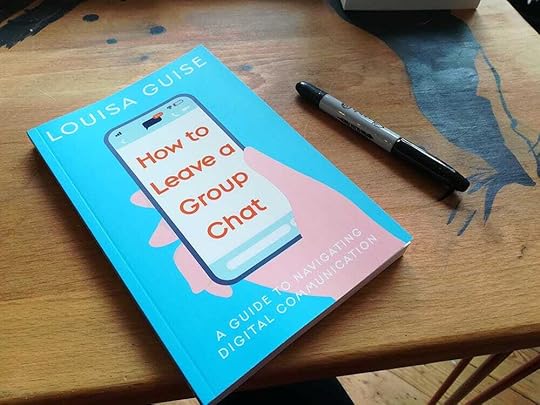How do I write a book?

The topic being addressed in today’s blog seems, well, a little obvious. Yet time and time again I see posts in writing groups on Facebook, or occasionally Twitter (aka X) that ask, “How do I write a book?”. And this is the very reason that I am writing this blog, because people do keep asking “How do I write?” or “How do I write a book?”.
I suppose it’s not possible to turn back time and redo those English lessons that you should have paid attention to at school. So, here’s the next best thing.
Firstly – who are you, and why are you the person to write this book?This isn’t just a disruptive question to interrupt the flow of this How do I write a book blog post. These are the questions that every agent or publisher is going to be asking once they have received a manuscript from you, so it’s worth considering before you write.
For example: I’m Louisa Guise and I’m the author of How to Leave a Group Chat, a book about balancing your relationship with your smartphone. As I am a published author, have a long career as a content writer and also a poet, I think it’s fair to say that I am in a good position to write a blog about how to write a book.
What you write might just come, that writer’s phenomenon of pieces just writing themselves. But even if you don’t have a backstory, it’s worth coming up with one for later down the line.
Back to the blog – How do I write a book?Step 1: Get a pen and paper, or a computer, typewriter or a smartphone (I have written in my notes programme or even in unsent text messages when times are desperate).
Step 2: Write a word.
Step 3: Write more words so that you have a sentence.
That’s it! Just keep writing. See what comes.
Plotting your bookSome books flow on their own, but some require a bit of plotting to ensure that this happens. My own book How to Leave a Group Chat (pictured above) began life as pages and pages of notes because it’s a non-fiction book and I wanted to ensure that the information that I was writing was structured, cohereant and that information was not accidently repeated (or contradictory!).
The pages of notes were arranged something like this:
IntroductionFlowery text
Talk generally about….
Mention….
Introduce Chapter 1
Chapter 1Introduce chapter
Talk about X
Talk about Y
Plotting a text doesn’t just help you arrange it, it can help you locate things later and it can make cutting or rearranging text easier. I updated my notes throughout the entire writing process.
What comes next?Eventually you’ll build up an abundance of text forming paragraphs and paragraphs that will become your chapters.
When should a chapter end?A chapter should end when it feels right to you. There’s no hard or fast rule about this. To get a feel for this, read. Read the books that interest you, that captivate you, or even those that don’t. Reading is the best way to become a better writer.
Where should I write my book?I’ve become accustomed to writing my book at my desk because I can no longer do without two screens, but I have previously written on my bed, on public transport, at the dining table or even on the sofa. Some people like to write in the library, or at a cafe. Generally anywhere calm or comfortable without distractions is recommended.
 @louisaguiseauthorWhere do you write yours? #booktok #writer #writers #writersoftiktok #book #books #editing #editing101 #editingskills #inthemaking [image error]Tiktok failed to load.
@louisaguiseauthorWhere do you write yours? #booktok #writer #writers #writersoftiktok #book #books #editing #editing101 #editingskills #inthemaking [image error]Tiktok failed to load.Enable 3rd party cookies or use another browserShould I use AI to write?
Long answer short – No! The point of writing is that well-constructed texts are crafted from the beautiful minds of those with talent and imagination. AI programmes have neither talent nor imagination. They are not magic, and they do not construct prose out of nothing, but instead pull in words from content that already exists. This could leave you liable to plagiarism, or gross inaccuracies – both factual and grammatical. If you use AI, you are not a writer and it’s not your own work. It’s also unfair on those who are writers.
RedraftsYou’re unlikely to have a masterpiece after one draft. Every so often read back through your work and make changes to make it even better. Again, there are no rules about how often this should be done. A good amount of writing is intuition, and that comes with practice.
No redrafting is complete without proof reading – I have already covered proof reading previously in another blog post.
Assistance for writersWriting-wise, my best resource (aside from education and books) is my writer’s group Caversham Writers. Having the support of other writers to bounce ideas off, review work and learn from has been invaluable. Group leader Adrian recently started a Caversham Writer’s Substack which I also recommend you check out for more information.
I recommend that you join a local writer’s group or start your own. Attend events at your local library or a local book festival. And read, just read everything!
Not everyone is a writerPractice can make perfect, however not everyone is a writer. And that’s okay. There are lots of other ways to share great ideas too such as art, podcasts or videos. The great thing about the internet is that it’s easier than ever to find your people and share your great ideas with them.
I hope that I have answered the question “How do I write a book?”. If you have any other questions, or want to share your own experience or tips, leave a comment below.
Thanks for reading All about Digital Marketing! Subscribe for free to receive new posts and support my work.



